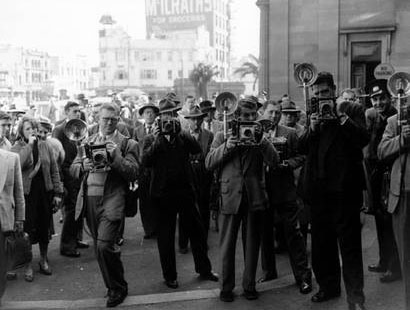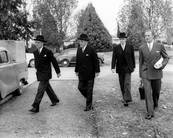Royal Commission

Photographers outside Darlinghurst Courthouse, Sydney, for the Petrov Royal Commission hearings. Photographer – Jack Hickson. Image courtesy of the Mitchell Library. State Library of New South Wales.
Conspiracy?
On April 13, the eve of the last Parliamentary sitting day before the 1954 election campaign, Prime Minister Robert Menzies announced the defection of Vladimir Petrov. He called for a Royal Commission to investigate evidence of espionage contained in the documents Petrov brought with him.
Leader of the Opposition, H V Evatt came to believe that the Petrov defections were part of a sinister conspiracy devised by Menzies, ASIO and Catholic anti-communist elements inside the Labor Party to secure a Coalition victory at the 1954 election. Members of Evatt’s staff had been named in the Petrov documents. He claimed they were forgeries sold by Petrov to the government to damage the Labor Party. He took his case to the Royal Commission.
On September 7 1954, after a series of extraordinary outbursts the Commissioners withdrew Evatt’s leave to appear before the Royal Commission. They argued that he was representing his own political interests as Leader of the Opposition and not his clients’ interests. Evatt’s suspicion of a conspiracy deepened as a result of his dismissal.

The Commissioners arrive at the preliminary Petrov Royal Commission hearing, Albert Hall. Photographer – Norm Danvers.
Image courtesy of the Mitchell Library. State Library of New South Wales.
The final report of the Royal Commission was released on September 14 1955. It concluded that the Petrov documents were genuine and that the Petrovs were ‘witnesses of truth’. However no prosecutions were recommended as a result of the inquiry. Although the Commission cast suspicion on six men – Fergan O’Sullivan, Rupert Lockwood, Frances Bernie, Ian Milner, Jim Hill and Walter Clayton – there was no existing Australian law covering their alleged crimes. In the case of Milner and Hill the Commission’s judgement rested on evidence that could not have been produced in court—the results of a top-secret code breaking operation.
The same day Evatt admonished the Commissioners for their failure to expose what he regarded as the Petrov conspiracy. Less than a week later, Evatt initiated the ill-fated (for him) Molotov debate in the House of Representatives.
During his speech Evatt announced that he had written to the Soviet Foreign Minister, Molotov, asking him to confirm if the Petrov documents were forgeries. The Hansard records could not capture what followed—a moment of stunned silence followed by outbursts of laughter from both sides of the House. Evatt had essentially asked the Soviet Foreign Minister to confirm whether the Russians had spies in Australia. Not surprisingly, the answer was no.
— Dr Evatt invokes Molotov in the House of Representatives, 19th October 1954. Courtesy of the National Archives of Australia
A week later Menzies replied. Rather than refuting Evatt’s speech point by point, he positioned himself as the ‘elder statesman’ seeking to maintain reason in the face of Evatt’s wild accusations. Many regard it as one of his finest speeches. Evatt’s reputation never fully recovered.
— Prime Minister Menzies defends the Royal Commission. Courtesy of the National Archives of Australia.
The Petrov Royal Commission was reviled by many on the left of Australian politics as being little more than a McCarthyist show trial. Recent evidence, however, suggests that the Commission was properly conducted and had strong grounds to support their conclusions.
Key documents
Among the documents Petrov brought across upon defection were documents labelled H and J.
The document labelled J was was written by prominent Australian communist Rupert Lockwood for the Russians, whom he regarded as allies in the battle against fascism. It outlined what Lockwood perceived as American and Japanese attempts to imperialise Australia.
Document J is one of the most debated and dissected documents in Australian history. ASIO believed it was little more than Communist propaganda. Evatt believed it contained proof of conspiracy. Page 35 named three of Evatt’s staff as sources of information – Fergan O’Sullivan, Albert Grundeman and Allan Dalziel. Evatt claimed page 35 had been added to the document in order to damage the Labor Party. He went to great lengths to try and prove it – examining the document for inconsistencies in the handwriting and staple marks. The Commission concluded that Document J was entirely Lockwood’s work.
— Journalist Bernard Freedman on Document H. Old Parliament House collection.
Document H was written by the Press Secretary to Dr Evatt, Fergan O’Sullivan. It was a series of biographical observation of the 1952 Press Gallery. The comments were unflattering and widely accepted as being untrue. O’Sullivan argued that it was intended to help the Russians place pro-Soviet articles in the Australian press.
In fact it was used by Moscow to identify potential agents. After the document was brought before the Commission O’Sullivan’s career was ruined. Evatt sacked him and promptly accused O’Sullivan of being part of the conspiracy.
